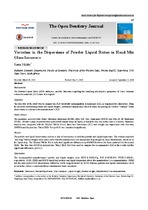| dc.contributor.author | Mulder, Riaan | |
| dc.date.accessioned | 2018-10-24T12:14:38Z | |
| dc.date.available | 2018-10-24T12:14:38Z | |
| dc.date.issued | 2018 | |
| dc.identifier.citation | Mulder, R. (2018). Variation in the dispersions of powder liquid ratios in hand-mix glass ionomers. The Open Dentistry Journal, 12: 647 - 658. | en_US |
| dc.identifier.issn | 1874-2106 | |
| dc.identifier.uri | http://dx.doi.org/10.2174/1745017901814010647 | |
| dc.identifier.uri | http://hdl.handle.net/10566/4154 | |
| dc.description.abstract | BACKGROUND:
The Powder/Liquid Ratio (PLR) influence, and the literature regarding the handling and physical properties of Glass Ionomer
restorative materials (GIC) were investigated.
OBJECTIVE:
The objective of the study was to compare the PLR variability and magnitude in hand-mix GICs, as dispensed for clinical use. From
the recorded individual powder and liquid weights, additional comparisons could be made by pairing the various “extreme” outer
observations in relation to the manufacturer’s PLR.
STUDY DESIGN:
The materials assessed were Ketac Universal Hand-mix (KUH), Riva Self Cure Hand-mix (RSCH) and Fuji IX GP Hand-mix
(FIXH). Twenty scoops of powder were paired with twenty drops of liquid, as would be the case in the clinical scenario. Statistical
analysis was completed with the Kruskal Wallis H test, Intraclass Correlation (ICC) and straight line regressions with One-way
ANOVA and the post-hoc Tukey HSD Test (p<0.05 was considered significant).
RESULTS:
The powder and liquid observations indicate a lack of consistency in both the powder and liquid dispersions. The volume remained
“one drop” but the weights were much lower than the manufacturer’s recommended drop weight for some observations, due to air in
the liquid drop. The Kruskal-Wallis H test indicated significant differences (p=0.0001) between the three materials for the paired
PLRs. The One-way ANOVA and post-hoc Tukey HSD Test were used to compare the recommended PLR to the results and the
significant differences (p<0.01).
CONCLUSION:
The recommended manufacturers’ powder and liquid weights were KUH 0.150/0.05g; RSC 0.165/0.035; FIXH 0.18/0.05,
respectively. KUH, FIXH and RSCH liquid had powder and liquid dispersions above the manufacturer’s recommendations. FIXH
had the most paired PLR observations within the ±10% range followed by KUH. Extreme powder and liquid combinations could
occur in the clinical scenario and these combinations were considered. | en_US |
| dc.language.iso | en | en_US |
| dc.publisher | Bentham Open | en_US |
| dc.rights | © 2018 Riaan Mulder.
This is an open access article distributed under the terms of the Creative Commons Attribution 4.0 International Public License (CC-BY 4.0), a
copy of which is available at: (https://creativecommons.org/licenses/by/4.0/legalcode). This license permits unrestricted use, distribution, and
reproduction in any medium, provided the original author and source are credited | |
| dc.subject | Hand-mix | en_US |
| dc.subject | Powder/liquid ratio | en_US |
| dc.subject | Glass ionomer | en_US |
| dc.subject | Liquid weight | en_US |
| dc.subject | Powder weight | en_US |
| dc.subject | Manufacturer’s recommendation | en_US |
| dc.title | Variation in the dispersions of powder liquid ratios in hand-mix glass ionomers | en_US |
| dc.type | Article | en_US |
| dc.privacy.showsubmitter | FALSE | |
| dc.status.ispeerreviewed | TRUE | |

